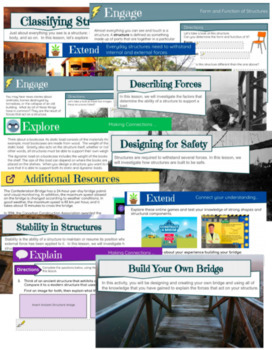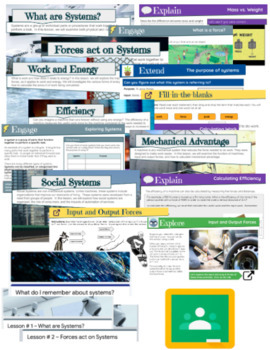Grade 7&8 Science Unit Bundle (STRAND 2 - Understanding Structures & Mechanisms)
- Zip
What educators are saying
Products in this Bundle (2)
Bonus
Also included in
- In this bundle, I have added all four Grade 7 Science and Technology Units. These lessons were made as a resource for my students "learning from home". Each lesson is was created with Ontario Science and Technology curriculum in mind.Unit 1 ~ Interactions in the Ecosystem (Nine Interactive Lessons)LPrice $93.60Original Price $104.00Save $10.40
Description
In this bundle, I have added the Grade 7 Structures Unit and Grade 8 Systems in Action Unit. These lessons were made as a resource for my students "learning from home". Each lesson is was created with Ontario Science and Technology curriculum in mind.
Grade 7 - Structures Unit Overview
Lesson One - Classification of Structures
Just about everything you see is a structure: buildings, cars, trees, bicycles, your body, and so on. In this lesson, let’s explore how structures can be classified.
Lesson 2 - Forces that act on Structures
Structures are designed to withstand the forces that act on them. Some of those forces come from the outside of the structure, whereas, some come from within. In this lesson, let’s explore these forces.
Lesson 3 - Describing Forces
In this lesson, we will investigate the factors that determine the ability of a structure to support a load.
Lesson 4 - Designing for Safety
Structures are required to withstand several forces. In this lesson, we will investigate how structures are built to be safe.
Lesson 5 - Stability in Structures
Stability is the ability of a structure to maintain or resume its position when an external force has been applied to it. In this lesson, we will investigate how structures are designed for strength, stability, function, and form.
Build Your Own Bridge - A culminating task
In this activity, you will be designing and creating your own bridge and using all of the knowledge that you have gained to explain the forces that act on your structure.
Grade 8 - Systems in Action Unit Overview
Before your begin, have your students complete this Google Form titled "What I remember about systems?
Lesson # 1 ~ What are Systems?
Systems are a group of individual parts or procedures that work together to perform a task. In this lesson, we will examine both physical and natural systems.
Lesson # 2 ~ Forces act on Systems
Every object in the universe experiences forces. All the different forces can be classified as contact forces or action-at-a-distance forces. In this lesson, let’s explore these forces.
Lesson # 3 ~ Work and Energy
What is work and how does it relate to energy? In this lesson, we will explore the impact of forces, as it applies to work and energy. We will investigate the various forms of energy and how to calculate the amount of work being completed.
Lesson # 4~ Mechanical Advantage
A machine is any mechanical system that reduces the force needed to do work. They were designed to make work easier. In this lesson, we will examine the function of machines, input and output forces, and how to calculate mechanical advantage.
Lesson # 5 ~ Efficiency
Can you imagine a machine that runs forever without using any energy? The efficiency of a machine measures the useful work done by the machine compared to the work needed to operate it. In this lesson, we will calculate efficiency, as well as, examine ways to increase it.
Lesson # 6 ~ Social Systems
Social Systems are non-mechanical systems. Unlike machines, these systems include organizations that improve our standards of living. These systems were developed from a need from groups of people. In this lesson, we will explore how social systems are organized, the role of consumers, and the impacts of automation of services.





